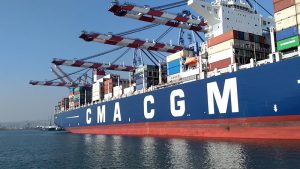 The Port of Los Angeles and that of adjacent Long Beach form together the largest port in the United States. They are among the top 20 container ports in the world.
The Port of Los Angeles and that of adjacent Long Beach form together the largest port in the United States. They are among the top 20 container ports in the world.
Native hunters, gatherers and fishermen lived in nutrient-rich and pleasant California from about 13,000 BC. The Tongva Indians were located in the area where now the port of Los Angeles is. Portuguese navigator Juan Rodriguez Cabrillo was the first European to anchor here in 1542; on the cliffs he saw plumes of smoke from the Indians. He named the place Bahia de los Fumos, the Bay of Smoke. From 1769, Spanish missionaries and military personnel settled on the California west coast, they founded a series of mission posts, such as El pueblo de la reina de Los Angeles, The City of the Queen of Angels, later shortened to Los Angeles. Numerous large farms were established around the mission post, which kept huge herds and where the Tongvas and other Indians had to work as forced laborers. On the coast was a trading post, San Pedro. From there, cowhides, talc and otter skins were exported.
In the mid-nineteenth century, about twenty to thirty sailing ships anchored yearly in the bay of San Pedro. Those ships were unloaded and loaded via rowing boats. After Mexico’s independence from Spain, in 1821, California became Mexican. But the United States did not accept that, they declared war on Mexico, and they won it. As a result, Mexico had to relinquish one third of its territory; California, Texas, and other areas to the United States in 1848.
The violence against the Indians continued. “California is based on the extermination of the Indians,” says historian Benjamin Madley.
Around 1850, gold was found near San Francisco, 600 kilometers north of Los Angeles. A massive run of gold seekers from the whole world started. The port of San Francisco grew very fast, and the port of San Pedro also benefited from the Goldrush. A lot of wood arrived for the construction of houses in Los Angeles, and San Pedro also became an important fishing port. The opening of the Panama Canal in 1914 made the port attractive for international shipping. Until then, ships from Europe and the east coast of the United States had to sail around Cape Horn in South America. The discovery of oil in the wider Los Angeles area increased the prosperity. And the arrival of film companies made the city even more popular.
During World War II (1940-1945), San Pedro became a port of war, where hundreds of Liberty and Victoria ships were built to bring cargo, soldiers, and war equipment to Europe. Those ships contributed to the globalization of the American economy after the war.
Around 1960, an American road builder, Malcolm McLean, placed a few large chests on old war tankers. That was the beginning of the use of boxes, containers, in transport by ships. The ports of Los Angeles and Long Beach grew quickly. The harbor basins had to be dredged continuously. The heavy traffic of trucks transporting the containers released a lot of fine dust, causing residents to suffer from asthma and cancer. By adopting a Clean Air Action Plan that drastically reduced sulfur, nitrogen and particulate emissions, the ports of Los Angeles and Long Beach became pioneers in applying environmental measures to improve air quality and curb climate change.




